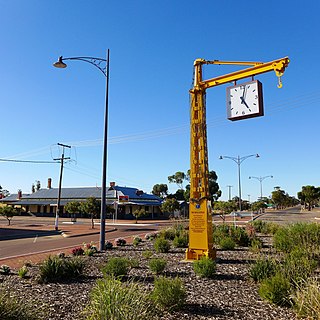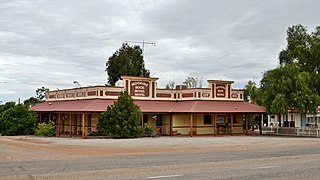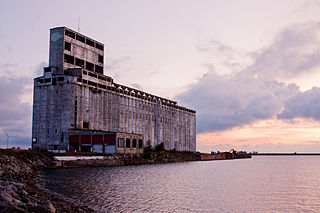Related Research Articles

A grain elevator is a facility designed to stockpile or store grain. In the grain trade, the term "grain elevator" also describes a tower containing a bucket elevator or a pneumatic conveyor, which scoops up grain from a lower level and deposits it in a silo or other storage facility.

Narembeen is a town in the Wheatbelt region of Western Australia. It is 286 km, almost due east, from Perth, the capital of WA. It is the major settlement in the Shire of Narembeen, in which the major industries are growing cereal crops and raising cattle and sheep. The surrounding areas produce wheat and other cereal crops. The town is a receival site for Cooperative Bulk Handling.

Newdegate is a townsite in the Great Southern agricultural region, 399 km south-east of Perth and 52 km east of Lake Grace in Western Australia. The townsite was gazetted in 1925 and honours Sir Francis Newdegate, the Governor of Western Australia from 1920 to 1924. The Department of Agriculture and Food operates one of its 13 research stations in the area of Newdegate.

Perenjori is a townsite in the northern agricultural region, 348 kilometres (216 mi) north of Perth and 39 kilometres (24 mi) south-east of Morawa. It is located on the Wongan Hills to Mullewa railway line which was opened in 1915. Perenjori was approved as the name of a siding in April 1913, and later that year the government decided to establish a townsite there. Perenjori townsite was gazetted in 1916.

Burracoppin is a townsite on the Great Eastern Highway, east of Merredin in the Wheatbelt region of Western Australia.

Moorine Rock is located in the eastern agricultural region of Western Australia, 347 km east of Perth and 22 km west south west of Southern Cross.

Brookton is a town in the Wheatbelt region of Western Australia, 138 kilometres (86 mi) from the state capital, Perth via the Brookton Highway where it crosses the Great Southern Highway. The town is on the Great Southern railway line. It is within, and is the seat of government for, the Shire of Brookton. At the 2016 census, Brookton had a population of 975.

The Alberta Wheat Pool was the first of Canada's wheat farmer co-operatives in 1923.

Mukinbudin is a small town in the north eastern Wheatbelt region of Western Australia, approximately 298 kilometres (185 mi) east of Perth and 80 kilometres (50 mi) north of Merredin near Lake Campion. It is the main town in the Shire of Mukinbudin. At the 2021 Australian census, Mukinbudin had a population of 336.

Trayning is a town in the north-eastern Wheatbelt region of Western Australia, 236 kilometres (147 mi) east of the state capital, Perth, on the Nungarin–Wyalkatchem Road. At the 2006 census, Trayning had a population of 122.

Nungarin is a town located in the north east of the Wheatbelt region of Western Australia, approximately 278 kilometres (173 mi) east of Perth and 39 kilometres (24 mi) north of Merredin. It is the main town in the Shire of Nungarin. At the 2006 census, Nungarin had a population of 142.

Ardath is a small town in the Wheatbelt region of Western Australia 20 kilometres (12 mi) south of the town of Bruce Rock.

Miling is a small town in the Shire of Moora, 200 kilometres (124 mi) north of Perth, Western Australia. At the 2021 census, it had a population of 101.

The CBH Group, is a grain growers' cooperative that handles, markets and processes grain from the wheatbelt of Western Australia.
Yuna is a small town in the Mid West region of Western Australia, in the Shire of Chapman Valley, 62 kilometres (39 mi) northeast of the city of Geraldton.

A wheat pool is a co-operative that markets grain on behalf of its farmer-members.
Bowgada is a small town in Western Australia located on the Mullewa Wubin Road 366 kilometres (227 mi) north of Perth in the Mid West region.

The Cargill Pool Elevator is a grain storage facility in Buffalo harbor built in the 1920s and previously named the Saskatchewan Cooperative Elevator. The elevator is the only grain elevator in Buffalo that is located directly adjacent to Lake Erie.
The wheat industry of Australia has been organised by government regulation, by both the Commonwealth Government and state governments.

CBH grain receival points are grain silos spread around Western Australia, primarily in the wheatbelt region. Historically they have been linked with the wheatbelt railway lines, and the transport of grain to ports for export.
References
- ↑ "Biography – Charles Walter Harper". Australian Dictionary of Biography. Australian National University. 2013. Retrieved 7 April 2013.
- ↑ "Co-operative wheat pool". The West Australian . Perth: National Library of Australia. 23 June 1922. p. 6. Retrieved 10 April 2013.
- ↑ "Co-operative wheat pool". The West Australian . Perth: National Library of Australia. 8 December 1922. p. 7. Retrieved 10 April 2013.
- ↑ "Co-operative wheat pool". The West Australian . Perth: National Library of Australia. 26 March 1923. p. 7. Retrieved 10 April 2013.
- ↑ "The wheat pool". The West Australian . Perth: National Library of Australia. 14 August 1925. p. 9. Retrieved 11 April 2013.
- ↑ "Wheat pool closure". Sunday Times . Perth: National Library of Australia. 26 April 1925. p. 7. Retrieved 12 April 2013.
- ↑ "Trade and Finance". The West Australian . Perth: National Library of Australia. 26 October 1927. p. 11. Retrieved 11 April 2013.
- ↑ "India buys wheat". The Daily News . Perth: National Library of Australia. 27 December 1928. p. 6. Retrieved 12 April 2013.
- ↑ "A record cargo from Geraldton". The West Australian . Perth: National Library of Australia. 4 February 1930. p. 16. Retrieved 11 April 2013.
- ↑ "Bulk Handling". The West Australian . Perth: National Library of Australia. 7 July 1933. p. 18. Retrieved 10 April 2013.
- ↑ "The co-operative bulk handling scheme". The West Australian . Perth: National Library of Australia. 24 September 1932. p. 20. Retrieved 11 April 2013.
- ↑ "Local and General". Albany Advertiser . Western Australia: National Library of Australia. 17 October 1935. p. 2. Retrieved 12 April 2013.
- ↑ "Wheat Crops". The West Australian . Perth: National Library of Australia. 1 July 1943. p. 2. Retrieved 13 April 2013.